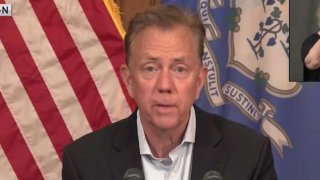
With a large wave of retirements expected throughout Connecticut state government next year, discussions are underway about how to ensure many of those soon-to-be vacant positions will be filled with more diverse workers, in addition to making sure the state can continue to adequately provide services.
The examination comes as recent data indicates certain executive branch state agencies remain mostly dominated by white males, lagging behind others when it comes to hiring people of color and women.
“These retirements cause a risk to the quality and availability of services, for sure,” said Mohamad Alkadry, head of the Department of Public Policy at UConn, recently addressing members of a legislative task force charged with coming up with recommendations for addressing what’s been described as a potential “tsunami” of retirements.
“But there’s also an opportunity to address the disparities in representation and past injustice in terms of representation,” said Alkadry.
Get Connecticut local news, weather forecasts and entertainment stories to your inbox. Sign up for NBC Connecticut newsletters.
Besides the task force, which is scheduled to present recommendations to the General Assembly in February, Democratic Gov. Ned Lamont’s administration and the Department of Administrative Services are also considering how to include greater diversity as they work to address what could be thousands of retirements.
“The short answer to ‘do we think this is an opportunity to ensure we have a diverse workforce?’ is yes,” said Lora Rae Anderson, director of communications to State Chief Operating Officer Josh Geballe, who is also the DAS commissioner.
A consultant’s report released in July by the Boston Consulting Group and commissioned by the Lamont administration found that 72% of more than 8,000 executive branch state employees eligible to retire in 2022 are seriously considering it. More employees than usual are eligible for retirement because the average age of the state’s workforce is on the rise. Also, a formula for calculating pension and retiree health benefits will be different after June 30, creating a possible incentive for some employees.
Local
Roughly 30,000 people work full-time at executive branch agencies in Connecticut, while another 20,000 work for the courts, the General Assembly, hospital systems and the state universities. Those 20,000 were not included in the scope of the report.
Women continue to be underrepresented in certain agencies and divisions such as police services, highway operations, engineering and construction, and one prison included in another report produced by UConn and the State Comptroller’s Office. The analysis is based on data pulled in March 2021 of nearly 28,360 full-time state employees who work in executive branch agencies.
The same report found the number newly hired Black and Hispanic women for jobs in male-dominated state agencies is far below their representation in the overall Connecticut population. For example, between March 30, 2020, and March 30, 2021, 3.7% of the new hires were Black women, while they make up about 5% of the population. Hispanic women made up 2.8% of the new hires, despite comprising 7% of the population.
While the total number of white employees in executive branch agencies as a whole continues to exceed the percentage of white residents living in Connecticut— a gap that has diminished with new hires — the total number of Hispanic state employees is the most underrepresented group. The gap has worsened with new hires, according to the report.
Anderson said the state of Connecticut’s recruitment staff have already been thinking critically about ways to reach more diverse populations to fill the large numbers of anticipated open positions, such as sharing information about job opportunities through new outlets, including print and digital. She said the public “in all communities” can expect to see more information about state job openings in the coming months.
She said the administration also plans to rely on the community-based partnerships it made during the COVID-19 pandemic, including those in minority communities, calling them “critical” to the state’s recruitment process.
“We hope many of these relationships we have forged will help make sure we have a representative staff in state government,” Anderson said in an email.
Creating a “tool kit” of training programs and partnerships for state agencies, providing free tuition for certain professions, reaching out to young people while they’re still in high school, and resurrecting old leadership training programs for state employees that were scrapped or scaled back because of state budget constraints were some of the ideas discussed recently by task force members.
Assistant State Comptroller Tara Downes recommended against a one-size-fits-all-approach to diversifying state government.
“It has to be an agency-by-agency program because State Police are going to have a totally different need than the State Comptroller’s office or recruiting for IT versus recruiting for police protective service,” she told task force members. “So it’s going to have to be an agency-by-agency strategy.”



